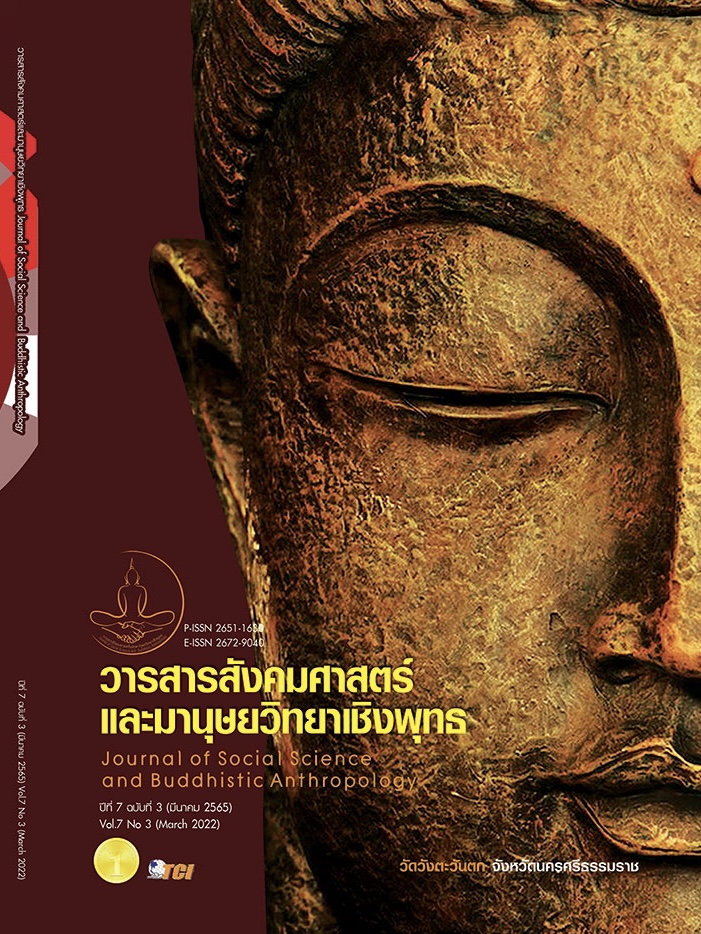ASPECTS OF COOKING TERMS IN THAI AND LAOS COOKBOOKS: A COMPARATIVE STUDY
Keywords:
Aspects of Cooking Terms, Thai and Laos Cook Books, A Comparative StudyAbstract
The Objectives of this research article were to Cooking Terms in Thai and Lao Recipes purposes is to analyze and compare cooking terms as realized through Thai and Lao cookbooks by content analysis The selected Thai cookbooks include “Tamra KapKhao” by Lady Somchin Rajanuphraphan (Bunnag) published in 1891 and “Mae Krua hua Pa” by Her Ladyship Plian Phasakorawong (Bunnag) written in 1909. The Lao cookbook is “Traditional Recipes of Laos” which is written by Phiasing Chaleunsilp. He wrote his recipes as his journal and it was published in 2010. Results reveal that in both the Thai and Lao recipes, there are similar cooking terms. Those terms can be classified as names of dish, names of cooking equipments, and names of ingredient. The Thai and Lao cooking terms reflect similar ways of life of the Thai and Lao people in terms of consumption culture and cultural dissimilation. Futher, Thai and Laos cook books also reflected that people possess various cooking and food comsuption wisdoms such as improving tastes and aromas, flavoring, and using herbs. Thai and Laos people have placed importance to timing for cooking each dish as well as pay attention to plating and arranging a meal set. Thus they could design good mixing and perfect matching of ingredients or types of food for making a better combination are employed. This mixing and matching knowledge is recognised both to a given dish and arranging different kinds of food in a serving tray. In addition, Thailand and Laos has been long contacted with foreigners; hence, exchange and acculturation of food have occurred. Some foreign dishes have been adopted and adjusted to the tastes of Thai and Laos people.
References
โกสินทร์ ปัญญาอธิสิน. (2552). การศึกษาคำเรียกการทำอาหารในภาษาไทยถิ่นเหนือตามแนวอรรถศาสตร์ชาติพันธุ์. ใน วิทยานิพนธ์ภาษาศาสตร์มหาบัณฑิต สาขาภาษาศาสตร์. จุฬาลงกรณ์มหาวิทยาลัย.
ซ่มจีน ราชานุประพันธ์, หม่อม. (2434). ตำรากับเข้า. กรุงเทพมหานคร: วัชรินทร์.
ท่านผู้หญิงเปลี่ยน ภาสกรวงศ์. (2554). ตำราแม่ครัวหัวป่าก์ เล่ม 1-5. (พิมพ์ครั้งที่ 7). กรุงเทพมหานคร: สำนักพิมพ์ต้นฉบับ.
เปรม สวนสมุทร. (2560). ตำรับชาววัง : นวัตกรรมแห่งโภชณียประณีต. วารสารวิชาการนวัตกรรมสื่อสารสังคม, 5(2), 150-160.
เพียสิง จะเลินสิน. (2553). ตำรับอาหารพระราชวังหลวงพระบาง (จินดา จำเริญ, ผู้แปล). กรุงเทพมหานคร: ผีเสื้อลาว.
รัตนา จันทร์เทาว์ และเชิดชัย อุดมพันธ์. (2560). ชื่ออาหารท้องถิ่นอีสานและภาคใต้: มุมมองด้านอรรถศาสตร์ชาติพันธุ์. วารสารศิลปศาสตร์ มหาวิทยาลัยสงขลานครินทร์ วิทยาเขตหาดใหญ่, 9(1), 63-89.
รัตนา พรหมพิชัย. (2537). ลาบจิ๊น : บทบาททางสังคมและวัฒนธรรม กรณีศึกษา หมู่บ้านสันหลวงเหนือ หมู่ 10 ตำบลจันจว้าใต้ อำเภอแม่จัน จังหวัดเชียงราย. ใน วิทยานิพนธ์ศิลปศาสตรมหาบัณฑิต สาขาวิชาวัฒนธรรมศึกษา. มหาวิทยาลัยมหิดล.
ศศิธร สินถาวรกุล. (2547). วัฒนธรรมการกินของคนไทยที่สะท้อนจากชื่อขนมไทยที่ใช้ในงานเทศกาลพิธี. ใน วิทยานิพนธ์ภาษาศาสตร์มหาบัณฑิต สาขาภาษาศาสตร์. จุฬาลงกรณ์มหาวิทยาลัย.
สุนันท์ อัญชลีนุกูล. (2551). หลากมิติคำแสดงโภชนลักษณ์ในตำราอาหารไทย อังกฤษ ฝรั่งเศส. วารสารอักษรศาสตร์, 36(ฉบับพิเศษ), 251-277.
อนุมานราชธน, พระยา. (2524). การศึกษาเรื่องประเพณีไทย. กรุงเทพมหานคร: ราชบัณฑิตยสถาน.
อภิลักษณ์ เกษมผลกูล. (2560). ตำรากับข้าวชาววัง" ออกสู่โลกกว้าง: กำเนิดและพัฒนาการของ "ตำรากับข้าวชาววัง" ในสมัยรัชกาลที่ 5 จนถึงการตั้งโรงเรียนสตรี. วรรณวิทรรศน์, 17(2), 353-385.
Downloads
Published
How to Cite
Issue
Section
License
Copyright (c) 2022 Journal of Social Science and Buddhistic Anthropology

This work is licensed under a Creative Commons Attribution-NonCommercial-NoDerivatives 4.0 International License.








